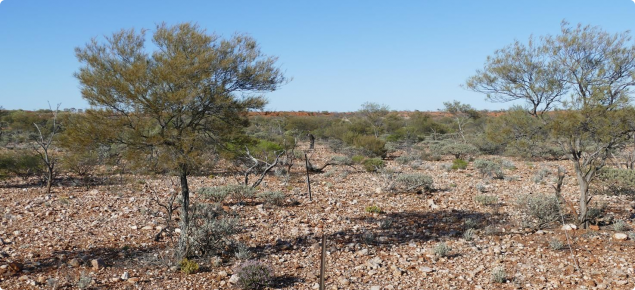Pastoral potential – very low
Rugged terrain and lack of water render some parts of these pastures inaccessible to stock and pastoral value is very low. Shallow soils and poor infiltration limit the establishment of perennial vegetation. Palatable perennials are scarce and durability in dry times is poor.
Suggested levels of use (per annum)
Table 1 provides a rough guide to the range of pastoral values for good condition pastures, which must be checked against conditions in each region and paddock. Carrying capacities for fair condition pastures might be 75% to 50% of good, and poor condition pastures less than 50% of good.
See Introduction to pastures in the southern rangelands of Western Australia for an explanation of how carrying capacities are estimated.
| Condition | Carrying capacity ha/DSE1 | Carrying capacity ha/CU2 (ha/AE3) |
|---|---|---|
| Good | >30 | >210 (≥252) |
1 DSE is based on the feed energy required to maintain a 45 kilogram liveweight Merino wether with zero weight change, no wool growth additional to that included in maintenance, and walking 7 km/day. 1 DSE has an energy requirement of approximately 8.7 MJ ME/day.
2 CU in the southern rangelands is based on a 400 kg steer at maintenance and equivalent to 7 DSE.
3 AE is based on the feed energy to maintain a 450 kg Bos taurus steer 2.25 years of age, walking 7 kilometres each day. 1 AE has an energy requirement of approximately 73 MJ ME/day and equivalent to 8.4 DSE.
Management
These pastures are rarely suitable for carrying stock on a year-long basis. At best, they allow sparse grazing at very low stocking rates. Closely spaced water must be available to ensure even grazing pressure. Fencing these pastures off from more attractive pastures will reduce the potential for preferential grazing of higher pastoral value pastures. Flushes of annual species after good seasonal rains can be grazed for the short period that green feed is abundant, which allows managers to spell better quality pastures and promote recruitment of palatable shrubs where fencing is adequate.
Fire is not a management tool for these pastures. In most years, there will not be enough fuel to carry a fire. In wet years, annuals and ephemerals may produce enough fuel to carry a fire.
Pasture condition
Surveys revealed significant patterns of reduced populations of total perennials, with much reduced populations and species counts of palatable perennials in areas close to waters (within 1–3km). Areas showing a reduction in palatable perennial plant coverage and a general loss of acacias from mid and upper strata may exhibit compensatory increases in cover from unpalatable eremophilas.
Survey data generally indicate stony acacia-cassia-eremophila pastures often remain in relatively good condition, with deterioration occurring slowly only after intense grazing pressure. Water availability for herbivores, in particular sheep, is an important factor influencing degradation. The Murchison River catchment survey found that nearly half of the surveyed points for these pastures were in poor condition and that palatable perennials averaged significantly less in the north-east quadrant of paddocks than elsewhere. This observation suggests sheep grazing pressure was particularly focused in the north-eastern sectors of paddocks.
Good
See Figure 1. The density and vigour of palatable perennial shrubs indicates the condition of stony acacia-cassia-eremophila pastures. Palatable perennials are generally sparsely distributed and cotton bush is the dominant species; however, warty-leaf eremophila, ruby saltbush, golden bluebush, tall saltbush and currant bush are all important locally. The presence of any of these species as healthy robust individual plants indicates good condition.
Total low shrub densities are commonly around 1500 per hectare but may vary between 600 and 4000/ha according to soil type and depth. Species of marginal palatability usually dominate the stand with grey cassia, crinkle leaf cassia and royal poverty bush occurring widely. Bardie bush, wait-a-while and needlebush may occur at densities below 50 plants per hectare.
Dense stony mantles usually provide some degree of protection to the shallow soil.
Fair
See Figure 2. Cassias and poverty bushes are dominant, similar to good condition pastures. The major distinction is a reduction in density or absence of living palatable perennial plants. Gully erosion is absent but sheet erosion may occur after heavy rainfall.
Poor
See Figure 3. Desirable species are absent and even the marginally palatable species remaining are grazed; there is an overall decline in density and diversity. Pastures are characterised by bare stony ground with only a few individual shrubs remaining. Rilling or gully erosion may be present, particularly in areas where stock pad lines have disturbed the surface mantle.
Stony acacia–cassia–eremophila pastures condition photographs
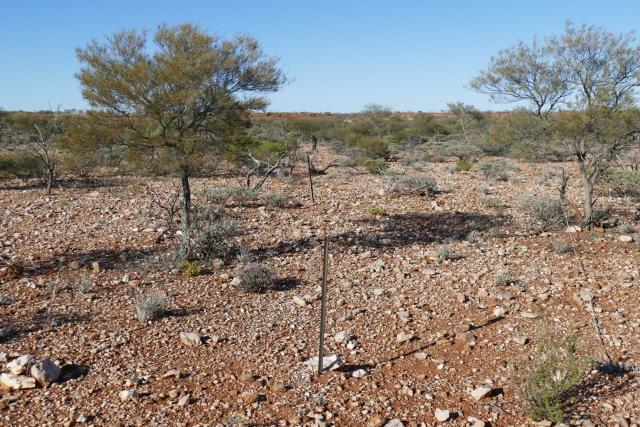
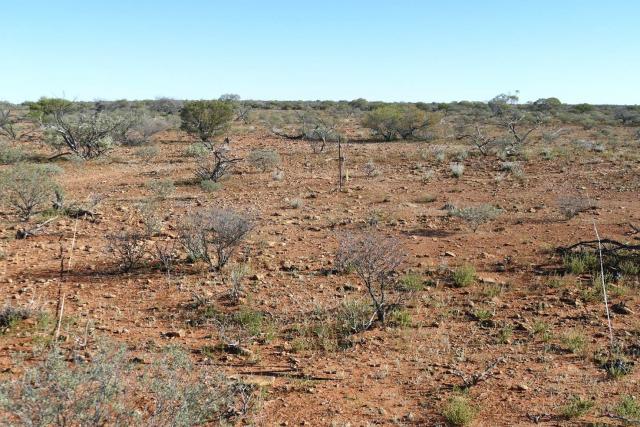
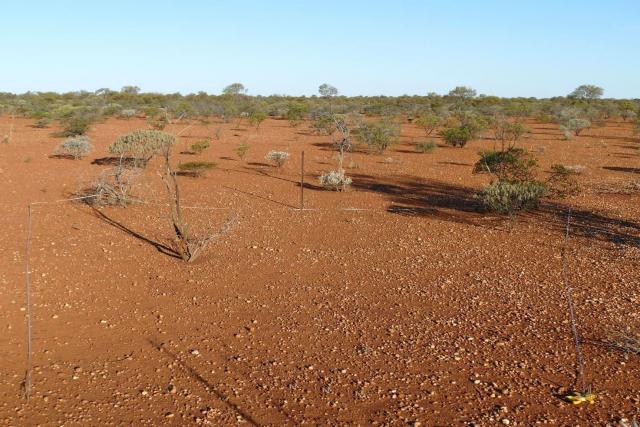
Vegetation structure and composition
Stony acacia-cassia-eremophila pastures typically occur as very scattered or scattered (PFC 2–15%) low (<2m) shrublands. Upper strata are very sparse or absent. Trees occur rarely and sparse tall shrubs may include mulga, curara or other acacias. Low shrubs form the dominant layer, although they are relatively sparse and contain fewer desirable species when compared with the similar, and often adjacent, acacia-cassia short grass forb pastures.
Common low shrubs include Murchison willow, grey cassia, crinkle leaf cassia, grey turpentine bush, limestone fuchsia, royal poverty bush, cotton bush and flannel bush. These pastures can also occur as tall (>2m) scattered (10–20% PFC) shrublands in restricted areas where mulga and curara are the dominant tall shrubs. Perennial grasses are generally absent and do not form an important component, though some may be present in creeklines and on open plains. Annual grasses and herbs provide considerable cover for a limited time in good seasons.
Occurrence estimate: 3.51Mha, 4.3% of the southern rangelands
Stony acacia-cassia-eremophila pastures occur on broad convex rises among undulating upland stony plains and near level interfluvial plains, and cover an estimated 3.51 million hectares (4.3% of the southern rangelands). Some small remnant plateaux also support these pastures. The soils are usually shallow (<60cm) red lithosols with sandy or loamy textures throughout the profile, though uniformly fine-textured and texture-contrast soils occasionally occur.
Surface mantles are a common feature and fragments of quartz, mixed or gneissic material often provide a dense cover (>50%). These pastures are often associated with hardpan mulga shrubland pastures, occurring in the landscape below them, as the interfluvial plains grade into adjacent sheetwash plains.
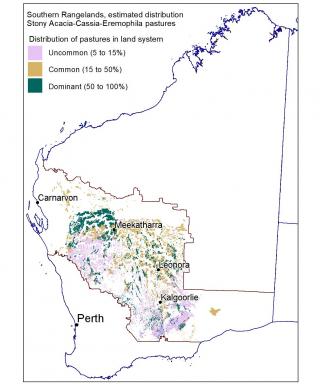
Associated plants
| Common name | Scientific name (links to FloraBase) | Desirability* |
|---|---|---|
| Berrigan | D | |
| Bluebushes | Maireana spp. | D |
| Cotton bush | D | |
| Curly windmill grass | D | |
| Currant bush | D | |
| Golden bluebush, George's bluebush | D | |
| Horse mulla mulla | D | |
| Ruby saltbush | D | |
| Scrambling saltbush | D | |
| Tall saltbush | D | |
| Tall sida | D | |
| Warty-leaf eremophila | D | |
| Wilcox bush | D | |
| Bardie bush | U | |
| Bloodbush | U | |
| Broom bush | U | |
| Crinkle leaf cassia | U | |
| Desert cassia | U | |
| Grey cassia, desert cassia | U | |
| Grey turpentine bush | U | |
| Limestone fuchsia | Eremophila sp. | U |
| Needlebush | U | |
| Royal poverty bush | U | |
| Sandbank poverty bush | U | |
| Spoon-leaf eremophila | U | |
| Straight leaf cassia, variable cassia | U | |
| Turpentine bush | U | |
| Wait-a-while | U | |
| Bowgada, wanyu, horse mulga | I | |
| Curara | I | |
| Fine leaf jam | I | |
| Flannel bush | I | |
| Gidgee, yalardy | I | |
| Granite poverty bush | I | |
| Jam | I | |
| Minniritchie | I | |
| Mulga | I | |
| Murchison willow | I | |
| Poverty bush | I | |
| Western myall | I | |
| White cassia | I | |
| Royal mulla mulla | N |
* D = desirable, U = undesirable, I = intermediate, N = no indicator value, ann. = annual

